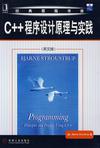C++程序设计原理与实践
出版时间:2009-10 出版社:机械工业出版社 作者:Bjarne Stroustrup 页数:1236
Tag标签:无
前言
Programming is the art of expressing solutions to problems so that a computer can execute those solutions. Much of the effort in programming is spent finding and refining solutions. Often, a problem is only fully understood through the process of programming a solution for it.This book is for someone who has never programmed before but is willing to work hard to learn. It helps you understand the principles and acquire the practical skills of programming using the C++ programming language. My aim is for you to gain sufficient knowledge and experience to perform simple useful programming tasks using the best up-to-date techniques. How long will that take? As part of a first-year university course, you can work through this book in a semester (assuming that you have a workload of four courses of average difficulty). If you work by yourself, don't expect to spend less time than that (maybe 15 hours a week for 14 weeks).Three months may seem a long time, but there's a lot to learn and you'll be writing your ftrst simple programs after about an hour. Also, all learning is gradual: each chapter introduces new useful concepts and illustrates them with examples inspired by real-world uses. Your ability to express ideas in code - getting a computer to do what you want it to do - gradually and steadily increases as you go along. I never say, "Learn a month's worth of theory and then see if you can use it."
内容概要
·为编写实际的应用程序做好准备 无论你是为了进行软件开发还是进行其他领域的工作。本书假定你的最终目标是学会编写实际有用的程序。 ·以基本概念和基本技术为重点 与传统的C++教材相比,本书对基本概念和基本技术的介绍更为深入。这会为你编写有用、正确.易维护和有效的代码打下坚实的基础。 ·用现代c++语言编程 本书一方面介绍了通用的程序设计方法(包括面向对象程序设计和泛型程序设计)。另一方面还对软件开发实践中使用最广泛的程序设计语言——C++进行了很好的介绍。本书从开篇就开始介绍现代C++程序设计技术,并介绍了大量关于如何使用C++标准库来简化程序设计的内容。 ·适用于初学者以及任何希望学习新知识的人 本书主要是为那些从未编写过程序的人编写的。而且已经由超过1000名大学一年级新生试用过。不过,对于专业人员和高年级学生来说,通过观察公认的程序设计大师如何处理编程中的各种问题。同样也会获得新的领悟和指引。 ·提供广阔的视野 本书第一部分非常广泛地介绍了基本程序设计技术,包括基本概念、设计和编程技术、语言特性以及标准库。这些内容教你如何编写具有输入、输出、计算以及简单图形显示等功能的程序。本书第二部分则介绍了一些更专门性的内容(如文本处理和测试),并提供了大量的参考资料。
作者简介
Bjarne Stroustrup英国剑桥大学计算机科学博士,C++语言的设计者和最初的实现者,也是《C++程序设计语言》(已由机械工业出版社引进出版)一书的作者。他现在是德州农工大学计算机科学首席教授。1993年,由于在C++领域的重大贡献,Bjame获得TACM的Grace Murray Hopper大
书籍目录
Preface Chapter 0 Notes to the Reader Chapter 1 Computers, People, and ProgrammingPart Ⅰ The Basics Chapter 2 Hello, World! Chapter 3 Objects, Types, and Values Chapter 4 Computation Chapter 5 Errors Chapter 6 Writing a Program Chapter 7 Completing a Program Chapter 8 Technicalities: Functions, etc. Chapter 9 Technicalities: Classes, etc.Part Ⅱ Input and Output Chapter 10 Input and Output Streams Chapter 11 Customizing Input and Output Chapter 12 A Display Model Chapter 13 Graphics Classes Chapter 14 Graphics Class Design Chapter 15 Graphing Functions and Data Chapter 16 Graphical User InterfacesPart Ⅲ Data and Algorithms Chapter 17 Vector and Free Store Chapter 18 Vectors and Arrays Chapter 19 Vector, Templates, and Exceptions Chapter 20 Containers and Iterators……Part Ⅳ Broadening the ViewPart Ⅴ AppendicesGlossaryBibliographyIndex
章节摘录
插图:The crucial concept here is feedback. We learn from experience and modify our behavior based on what we learn. That's essential for effective software development. For any large project, we don't know everything there is to know about the problem and its solution before we start. We can try out ideas and get feedback by programming, but in the earlier stages of development it is easier (and faster) to get feedback by writing down design ideas, trying out those design ideas, and using scenarios on friends. The best design tool we know of is a blackboard (use a whiteboard instead if you prefer chemical smells over chalk dust). Never design alone if you can avoid it! Don't start coding before you have tried out your ideas by explaining them to someone. Discuss designs and programming techniques with friends, colleagues, potential users, and so on before you head for the keyboard. It is amazing how much you can learn from simply trying to articulate an idea. After all, a program is nothing more than an expression (incode) of some ideas.Similarly, when you get stuck implementing a program, look up from the keyboard. Think about the problem itself, rather than your incomplete solution. Talk with someone: explain what you want to do and why it doesn't work. It's amazing how often you fred the solution just by carefully explaining the problem to someone. Don't debug (find program errors) alone if you don't have to!The focus of this book is implementation, and especially programming. We do not teach "problem solving" beyond giving you plenty of examples of problems and their solutions. Much of problem solving is recognizing a known problem and applying a known solution technique. Only when most subproblems are handled this way will you find the time to indulge in exciting and creative "outof-the-box thinking." So, we focus on showing how to express ideas dearly in code.
编辑推荐
《C++程序设计原理与实践(英文版)》:C++之父Bjarne Stroustrup的最新力作。
图书封面
图书标签Tags
无
评论、评分、阅读与下载
用户评论 (总计39条)
- 这书是不是没人买呀??怎么没看到新评论。。搞得我要自己写评论了,好书!
英文本身不复杂,C++之父有时还幽默一下。。看得很开心。。哈哈。。
C++二级必过! - 内容虽然是英文的,但都比较简单,易懂。不错
- 这种书必须打起十分的精神来,不过真的看进去了,确实非常令人兴奋。好多闪光点,老外这种细心的程度超过我的想像。
- 全英文看起来有些吃力,但是避免了中文版中的翻译晦涩难懂、歧义的问题。
- 专业人士必看
- 书很厚,还没来得及看,需要下一番功夫好好研究,值得购买。
- 买回来了还没怎么看,所以对内容就不发表评论了,可以肯定的是,这绝对是一本值得一读的C++入门书,我早就想买了O(∩_∩)O~
书很厚,拿起来那是相当的有感觉啊o(╯□╰)o
印刷很好,纸摸起来很舒服
总之很满意~嘿嘿 - 字太小了,图有些不清楚,其他都还不错,结合中文版练英文
- 无庸置疑,值得拥有!
- 我是中关村的程序员,我已我3年的编程经验告诉我,还是要买这本书,而且强烈推荐买原本英文的,仔细看过之后就是有着不一样的收获,大师就是大师,这个是原理性的东西,而不是淡淡的卖弄底层语言的技巧,推荐!
- 如果严格讲,这本书是C++的一本初级教程,我买来没什么大作用,但为何买了呢,主要是有一次看见了,入边有些地方(例如指针等等)有内存及相关对象模型,看上去比较不错,于是买了……
这本书我相信对于初学者比较不错,因为说得都比较浅白,在某些比较难理解的地方就有内存模型帮助理解,还有某些危险的操作(例如强制转换),会有什么危险也有一定图形说明,对于初学者的理解比较有好处!
当然,我相信很多的问题是英语版的,但老实讲,并不算太难! - 大师写的,就是不一样,道理讲得很好,对英语和C++两门语言都很有帮助,哈哈
- 封面看上去是有点久,不过经典书估计都这样了,内容看的清晰,用来学习很不错。
- there is not a plastic protect outside,and the book is somehow dirty,several pages of the back side are folded.meanwhile,the print is not that clear,looks ***e a copy.maybe it's the problem of the press.
- 很不错的教程,比较通俗易懂,并比翻译本好多了,避免了不必要的错。
- 挺不错的,正版,纸质挺好的,就是有点褶皱,总体还算满意。
- 比中文版好看多了。
- 子有些小,不能久看,习惯了也能凑合。
- 书还不错。。。就是物流极其的慢。。。一个多星期才回来的
- 书都皱了,脏了,还送给客户,当当怎么想的
- 说“教材”,可能不太恰当。所谓教材,在编写上比较精简,需要借助教师的讲解说明才能使学习者理解其概念、问题、情境、状况等。也许用“学材”二字比较合适,因为这本C++之父的著作正是一本十分适合“学习”的“材料”,它的讲解十分详尽(如果说它是一本教材,那它就是一本把老师在课堂上讲解到的甚至老师在课堂上没有时间讲解到的都一并写了进去),因此它才成为这样一部大部头,成为一部学习者的真正意义上的“学材”。比如,它甚至告诉你什么是变量、什么是字节、什么是位,难怪在美国大学里,一些从未接触过计算机编程的学生,经过学习这本“学材”,都能编写出较复杂的C++程序。更重要的一点是,它告诉你一种编程的思想,一种处理问题的方法,一种避免困境的策略!你曾经用某种高级语言编过程吗?没有。好,那这本书正是为你编写的!你是一位有丰富编程经验的程序员吗?是。好的,这本书也是为你编写的,因为在书中,你一定能发现很多闪光的编程思想,一位计算机科学博士、C++语言发明者的闪光思想!可是有一点,它是完全英文版的啊!不错,书中大概没有一个汉字(除了封面封底等处外),可是,从英语这个角度说,这是一本十分浅易的英文书,除了需要掌握一些必须的计算机专业词汇外,书中的单词都是十分常用的英文单词,也没有困难的语法现象。从某个角度说,这是一本非常好的英文快读材料。只是有个小遗憾,原版是彩色印...制,影印过来在大陆出版的这个版本是完全黑白的(除了封皮外),丢失了一些颜色信息,比如有些彩色标识的色彩含义无法得以表达。不过,其实也不影响阅读。 阅读更多 ›
- 这本书的原版,实际上不止图片是彩色的,文字也是有彩色重点部分的。但是这本影印版都是黑白,色彩全没了。而且为了配合华章的系列,每本影印版都很小……这个经典的一本书,哪怕贵一点,就不能印成原版彩色吗?
- 字忒小了,强烈谴责中。
- 拿到书第一感觉很失望,那么厚的书居然那么小,跟牛津词典大小差不多。天杀的出版社,能再印小点吗?干脆印成口袋书算了。
- 字太小了,把眼睛看坏了, 请不要购买
- 书很厚,比较小;最主要问题是图眼睛看的很难受,影印的缘故,因为原版很多图可能是彩色的。
- 机械工业出版社的东西印刷质量非常差,原书是彩色印刷的,这是阉割版,上当了
- 通熟易懂,深入浅出,不错
- 字体小就不说了!纸张还差到爆!
- 这本书看了快有三分之一了。从最初的编程的意义,什么是编程入手,对于那种对计算机编程一点都不清楚的人,做了详细的讲解,这当然是老外行书风格“当读者是傻子”的体现。之后再从例子中,不断引导着学习,不是那种直接告诉语法规则,再举例子的那种。每个章节的习题都值得好好做,因为没有一定时间的练习,我说的编程练习,是写不好代码,学不懂C++的,我相信,看完以后,正如本书作者,C++之父所言,能够应用于实际编程,能够开发出软件。如果要进阶的话,再看EFFECTIVE C++,STL STANDARD LIBARY。在此之前,我看过C++ primer 和primer plus,相对于没有任何C++编程经验的人来说,C++ primer 虽然为公认的入门书籍,我同学几乎是人手一本,但是并不适合作为入门书。另外推荐Bjarne Stroustrup本人的书C++ PROGRAMMING LANGUAGE,放在案头,随时查阅,实验室经常用C++来做通信仿真,必不可少。
- 英文版挺厚的,但粗略的看了下还不错
- 内容很通俗非常好,有英文功底的就比较好了
- 书很不错,虽然大家吐槽字太小,影响阅读,我觉得这个价钱,对得起这个质量了。我是从C转过来的,感觉难度不大,可惜就是内容太多了,不是很适合那些要快速应用的,比较适合慢慢学习。
- 千金难买心头好啊、、能拿到骨灰级大师的力作、、真的很高兴、、不过书有点厚、、字有点小
- C++之父写的,内容质量有保证。本书强调GUI的作用。另外,就是比较啰嗦,所以本书比较厚。说啰嗦是和克尼汉比较的。当然啰嗦也有好处,那就是本书可以一口气读到尾,不需要你来回翻多少。(交叉引用的内容基本直接重复一遍。)... 阅读更多
- 很好的的原版书籍。读起来很费劲,毕竟600多页。但是读过之后豁然开朗。推荐。
- 字有点小 几乎没有插图 内容是人家老外写的好
- 内容不错书太脏了,印刷也挺好。
- 很好的英文原著
